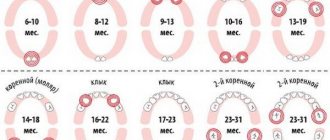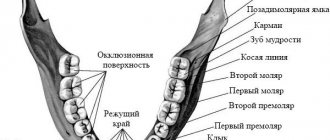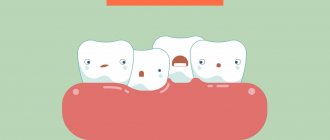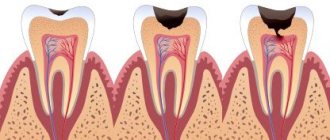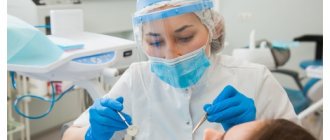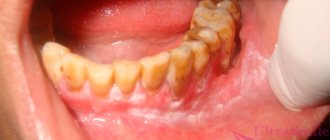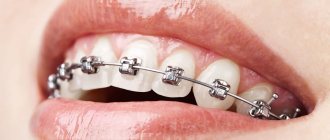Many parents still think that pediatric dentistry is needed only for exceptional cases: if the child has a severe toothache and the pain does not go away on its own. There is also an opinion that there is no need to do anything with baby teeth, because they will fall out anyway and give way to molars. These are erroneous opinions that the doctors at our clinic would even call dangerous.
Why does a child need a pediatric dentist? First of all, for preventive examinations and monitoring the growth of teeth and their replacement. The health of baby teeth is influenced by many factors. In turn, the health of the first teeth affects the condition of the molars even before they erupt. Next, we will understand how the change process occurs. Every parent should know this to help their child get straight, beautiful teeth and not experience problems in adulthood.
If you are still not used to taking your child to the pediatric dentist once every six months, it’s time to write down the date of the next visit on your calendar and make an appointment with us at the clinic in advance. This simple action will help prevent unpleasant problems and have a positive effect on the formation of the bite and the condition of the oral cavity.
In addition, early acquaintance with the doctor will help children form a good impression of the clinic. They will associate dental care at Mira children's dentistry in Krasnoyarsk with something festive and exciting! This is absolutely the opposite of the situation when you bring a child to the clinic with a severe toothache that requires treatment. A visit to the dentist will inevitably be remembered as something unpleasant.
What to do when teething?
The first teeth erupting will cause discomfort in the child, and this is a natural process. During this period, salivation increases, and a runny nose may occur due to the eruption of the upper teeth. The normal pace is for new teeth to appear every few weeks.
Be prepared for the fact that the child will be capricious and refuse to eat, and his temperature may rise. To make this period easier, you can use special teething toys. During this period, the gums become inflamed and cause discomfort - they can itch and hurt. Talk to your dentist: There are safe cooling gels for children that can help reduce the intensity of teething and teething symptoms in children.
It is also recommended to replace drinks with plain water. Juices and other drinks that contain sugar create an acidic environment in the mouth. Because of this, an inflammatory process may begin. Care should be taken to disinfect pacifiers and toys that children may put in their mouths.
The first teeth appear at the age of six months. The first chewing teeth appear between the ages of 1 and 1.5 years. Fangs are cut between the ages of 2 and 2. After this, by the age of 3, the following chewing teeth appear. Each new group requires attention. Thus, it is important to brush your chewing teeth well after eating, since the enamel of baby teeth is quite weak. Retention of food on the surface can easily cause inflammation.
It is also important to ensure that the child weans the habit of the pacifier and stops putting his fingers in his mouth. If this does not happen, an incorrect bite will be formed.
Abnormalities in tooth color
Let's be honest - a smile has a powerful communicative effect.
Therefore, aesthetic dentistry is developing at a rapid pace. Thanks to this, most people can have white, healthy teeth.
Let's close our eyes and imagine Julia Roberts for a minute. I bet everyone remembered the image where the actress smiles with her wide, snow-white smile, which immediately captivates the viewer.
In this article we will look at what is normal teeth color and what is a deviation from the norm, and most importantly, what to do and where to go.
1. Brown plaque. Reasons: most often these are tannin deposits from tea, coffee and other food colorings.
Solution: professional oral hygiene at the dentist and correction of manual skills when brushing teeth at home
2. Darker brown color. Reasons: such plaque occurs in smokers due to the penetration of tobacco tar into the tooth
Solution: professional oral hygiene, correction of home care, if this does not help, then you still have to quit smoking.
3. Black plaque in the neck of the tooth. Priestley's raid. Cause: Associated with color-producing bacteria, which form a dense coating of brown or black color. More common in children.
Solution: such plaque very quickly recurs again, almost immediately after professional oral hygiene. It is necessary to add a paste with enzymes, for example, from the Curaprox Enzical line, to your daily hygiene.
4. Green and orange plaque Cause: the relationship between poor oral hygiene and certain bacteria.
Solution: correction of oral hygiene, professional oral hygiene, correction of general somatic health.
5. Discoloration caused by antiseptics Reason: often long-term exposure to chlorhexidine as a result of which we get a gray coating.
Solution: do not prescribe antiseptic treatment for yourself, follow the recommendations of your dentist. Remove plaque using professional oral hygiene, eliminate antiseptics.
Next, we will look at dental discolorations associated with the penetration of dye into the tooth.
6. Fluorous teeth Cause: increased fluoride content in drinking water. It is an endemic disease.
Solution: depends on the severity of the lesion. Sometimes microabrasion and tooth restoration using filling material helps. In difficult cases - only prosthetics. The disease requires mandatory monitoring and observation by a dentist.
7. Tetracycline teeth Reason: taking tetracycline antibiotics at the time of formation of the rudiments of permanent teeth. Teeth are most susceptible to this antibiotic between the second trimester of fetal development and up to 8 years of age.
Solution: it is possible to completely remove the yellowish plaque only after prosthetics
8. Change in tooth color after root canal treatment Reason: there may be several, more often it is the remaining bacteria inside the tooth that stains the enamel and dentin black/brown/dark brown. It is possible to fill the root canal with resorcinol-formalin, then the tooth acquires a color from pink to dark purple.
Solution: mechanical and medicinal cleaning of the root canals is necessary, followed by tooth prosthetics.
9. Grayish-black color due to amalgam fillings Cause: Silver sulfide stains the walls of the tooth a dark gray color.
Solution: replacement of the filling, possible prosthetics.
10. Enamel hypoplasia Causes: many from nutritional deficiency to the influence of viral infections. Solution: depends on the severity of the lesion. Sometimes you can get by with additional home care, in other cases only prosthetics.
We have examined only some of the dental discororites that are more common in practice and in life. Treatment is always complex. This includes professional oral hygiene plus correction of home hygiene, possibly in-office whitening, and in difficult cases, prosthetics and consultation with third-party doctors such as a therapist, endocrinologist, gastroenterologist, etc.
In any case, anyone who wants to have a white, healthy smile can do so thanks to modern dentistry.
The order of changing baby teeth in children by age
After the age of 3 years, parents can take a little break from the changes. And then, at about 5 years of age, the baby teeth are replaced by permanent teeth. The process begins with the lower incisors. Then, after about a year, chewing “sixes” are cut, which parents may mistakenly mistake for milk ones. After another year, the upper incisors are replaced.
To go through this journey with your child without problems and pain, visit the dentist regularly. Children may experience pain simply from jaw expansion. Your doctor can easily tell you the cause of the discomfort. The age of 6–7 years shows the prospect of bite formation. Here you can quickly correct problems that arise so that by adolescence your child has a smooth, beautiful smile.
Next, the procedure for replacing baby teeth continues with the upper lateral incisors by the age of 8 years. At the age of 9–10 years, the molar first premolars appear, followed by the second premolars a year later. 12–13 years is the age when canines appear, and at 14 years the last second molars are cut.
The procedure for replacing baby teeth ends with the complete formation of a bite of 24 teeth.
Diseases of baby teeth
The most common troubles are caries (including bottle caries), pulpitis, periodontitis.
You should be alerted to any changes in the color of the enamel, spots, dots (both dark and white) on the child’s teeth, redness or swelling of the gums. But you don’t have to be afraid of uneven teeth at first: when chewing solid food, the baby teeth will move a little and gradually take the right place.
The causes of diseases in primary teeth are not very different from the causes of problems with permanent teeth. This:
- insufficient care for them (lack of proper hygiene),
- eating disorders,
- undermining of the immune system due to other diseases and taking certain medications.
It is a mistake to think that you can't take too much care of your baby teeth because they will fall out anyway. A diseased tooth in the mouth is a breeding ground for pathogenic bacteria, which not only destroy other teeth, but also negatively affect digestion and ENT organs. A prematurely lost baby tooth is also a problem, as it does not allow the baby to fully chew food or articulate sounds well. In addition, neighboring teeth try to occupy the vacated space - they move. And when a permanent tooth begins to grow here, it simply does not have enough space in the dentition and will have to grow sideways. That’s why it’s imperative to keep an eye on your baby teeth and treat them on time!
We ourselves, out of ignorance, introduce some pathogenic bacteria into the baby’s oral cavity. Suffice it to remember my grandmother’s method of disinfecting a fallen pacifier: lick it and put it in the baby’s mouth. How many times have we done this? Did you feed the child with your spoon? Did you take turns biting an apple or a bun with him? Imagine for a moment the state of your teeth and the newly formed, not fully formed, delicate teeth of the child. What danger did you expose them to?
Foreign microflora is especially harmful to a child under 2 years of age, while temporary teeth are maturing in his mouth and their enamel is very vulnerable.
Leftover food also contributes to the rapid proliferation of bacteria in the oral cavity. A by-product of their activity is acid, which eats away the enamel of a baby tooth, leaving its delicate base - dentin - without protection. Then it’s a matter of little things: microorganisms penetrate the dentin and destroy it. This is how caries occurs. Outwardly, a diseased tooth may look normal for quite some time: a small black dot (the site of the lesion) is not too noticeable. But inside it can already be severely damaged, since caries of baby teeth, due to the softness of their tissues, develops much faster than permanent teeth.
There is also the so-called “bottle caries” - this is a brownish plaque on the front teeth. It is very resistant and cannot be cleaned with a brush. Such teeth rot quickly. This caries is called “bottle caries” because it is a consequence of feeding the baby from a bottle with sweet drinks and juices at night and throughout the night. Carbohydrates are known to be the best food for bacteria. Receiving such wonderful nutrition, pathogenic bacteria rapidly multiply and take over the entire territory available to them. It will be very difficult to force them to give up their positions. The development of “bottle caries” is also facilitated by the fact that at night the natural protector and cleaner of teeth – saliva – is almost not produced. While you are sleeping peacefully, your baby’s fragile little teeth are under powerful attack and are not protected by anything! Is it worth it to buy yourself a vacation at such a price?
Dangerous complications of caries are pulpitis and periodontitis.
Pulpitis is an inflammation of the pulp (the core of the tooth, filled with vessels and nerve fibers). In children, the pulp is practically insensitive, so they may not feel the usual sign of pulpitis - sharp pain. As a result, pulpitis of baby teeth may not be noticed even by an attentive parent, and the role of preventive examinations by a dentist is irreplaceable here.
If bacteria pass through the root of a baby tooth and enter the gum tissue, inflammation begins - periodontitis. Severe pain and fever are already guaranteed here. The gums become red and swollen. Periodontitis is a serious disease, and a child should never be exposed to it.
By visiting your dentist in a timely manner, you can avoid all these troubles. Caries is very easy to treat. Here, however, the first question comes to mind: where exactly to turn. It turns out that the approach to the treatment of baby teeth in different clinics is very different.
Traditionally, caries of primary teeth is treated “in a hurry”: a small child usually does not really want to endure while the doctor picks around his mouth, so the doctor tries to somehow clean the damaged area and fill it with quick-hardening material. As a result, the affected teeth remain untreated and may soon become inflamed again or completely collapse. Sometimes you even have to put crowns on baby teeth.
“The Nutcracker” uses all the possibilities of modern medicine to provide comprehensive care to the smallest patients: from composite materials to “laughing gas” and Sevoran anesthesia. We are convinced that the treatment of primary teeth should be of high quality, and the child’s impressions of the clinic should be the most pleasant.
A baby tooth falls out, why and how it happens
Changing a child's baby (temporary) teeth to permanent ones is a natural process. It occurs as the jaw bones grow and develop. The task of parents, when baby teeth fall out, is to treat this with increased attention. There are often cases of malocclusion in children, which subsequently have to be corrected for a long time and then treated. One of the main reasons for this is a violation of the sequence of loss of primary teeth.
Sequence and estimated dates
Parents should know which baby teeth fall out first in children, as well as the sequence. Doctors adhere to the following scheme:
- Central incisors - 5-7 years;
- Lateral incisors - 7-8 years;
- Molars (1st upper jaw, 2nd lower jaw) - 9-11 years;
- Fangs - 9-12 years;
- Molars (2nd upper jaw, 1st lower jaw) - 10-13 years.
It is important to take into account that here is a generally accepted scheme and approximate dates when baby teeth fall out and permanent ones begin to appear, but depending on many factors there may be some changes that can be considered normal. However, if significant deviations are noticed, you should not delay your visit to the doctor.
When do teeth start to fall out and until what age?
With normal child development, this process begins at 5-7 years, but there may be deviations. Explained by the following factors:
- Heredity;
- Features of development;
- Gender of the child (girls earlier);
- Past illnesses;
- Presence of pathologies;
- Vitamin D deficiency;
- Injuries.
When a child’s baby tooth falls out, you shouldn’t be scared; you need to be prepared, as children often begin to complain of pain when biting into solid food. It is necessary to control the formation of the correct bite, for example, if the loss occurs much earlier or, on the contrary, with a great delay, then it is better to consult a dentist for advice
Content:
- Symptoms of teething in infants and young children
- Scheme of baby teeth eruption
- How to improve your baby's well-being
Every parent needs to know the order and timing of the eruption of baby teeth in children.
This information is necessary to understand what is bothering the baby and help him cope with uncomfortable symptoms. Also, if the mother knows the correct sequence of growth of time units, she may suspect something is wrong and make an appointment for the child to see an orthodontist. This will help avoid serious dental anomalies in adulthood.
Permanent teeth
So called because they already have full roots, permanent teeth begin to emerge at age five. This process will take 9 years. By the age of 14, the dental system is considered practically formed, not counting wisdom teeth (third molars), which erupt between the ages of 17 and 21, and not for everyone.
Important! All twenty primary teeth that grow in by 30 months must be replaced. Just like the order in which baby teeth appear, there is an order in which they fall out. The growth of indigenous plants also follows a certain pattern.
The structure of a child's and an adult's jaw differs in the number of teeth in it. There are 20 of them in children, 32 in adults.
Replacing teeth, unlike infant teething, does not cause such discomfort. But both their loss and their growth after the age of five are also accompanied by the opening of the gum tissue, so it is necessary to ensure that infection does not penetrate there.
By the way. Most often, viral stomatitis and other infectious dental diseases affect children who, during the period of loss of milk teeth and growth of permanent teeth, are not accustomed to maintain oral hygiene.
Eruption of molars
In order for permanent teeth to grow in place of milk teeth, the first ones must fall out and make room for them. Loss normally begins with the lower incisors, which are located in the center. But here the change in order is not anomalous, since it occurs depending on the characteristics of the child’s body.
- Teeth can change at four years or at five or six. Usually, starting from the fourth year, you can already expect that the lower incisors in the center will fall out. In their place, permanent incisors grow around the age of 6-7 years.
- And at the same time, the child’s first permanent molar grows, which does not occupy anyone’s place, but erupts in the row immediately after the first primary molar. The process can occur almost simultaneously from above and below.
- Further, from seven to eight years, the child loses his upper central and lower lateral incisors. In their place, molars of the same name grow.
- The process of loss of primary canines, premolars and molars can last up to twelve years. Instead, fangs and a pair of premolars erupt on each side above and below.
- The second-to-last molars grow, and by about 13-14 years of age the child already has all the molars, except for the third molars, which, as mentioned above, may appear after 20 years, or may not appear at all, or not completely or not all of them come out. .
Table. Eruption of molars
| Name | Age (in years) of eruption in the lower jaw | Age (in years) of eruption in the upper jaw |
| Incisors center | 6-7 | 7-8 |
| Lateral incisors | 7-8 | 8-9 |
| Fangs | 9-10 | 11-12 |
| First premolars | 10-12 | 10-11 |
| Second premolars | 11-12 | 10-12 |
| First molars | 6-7 | 6-7 |
| Second molars | 11-13 | 12-13 |
| Third molars | 16-25 | 16-25 |

